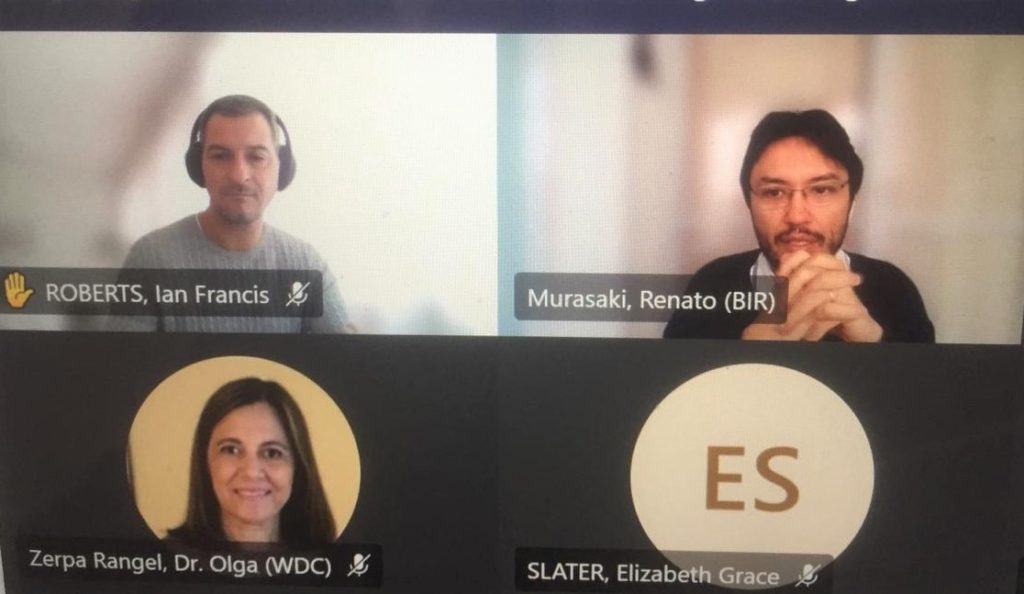BIREME has participated in the annual meeting of the Global Libraries Group (GLG) of the World Health Organization (WHO), held on 18 and 19 November, via web conference, presenting the advances of 2020 in the operation of the Global Index Medicus (GIM) and WHO’s global COVID-19 literature search interface. Coordinated by the WHO Digital Information Networks and Library Unit in Geneva, GLG has the participation of members from all the Regional Offices of the Organization. PAHO is represented in GLG by the Department of Evidence and Intelligence for Health Action (EIH) by Eliane Pereira dos Santos, Regional Advisor in Knowledge Management and Networks, and by BIREME who was represented at this event by Diego Gonzalez, Director, and Renato Murasaki, Information Technology Manager
GIM offers exclusive access to health evidence and information produced in low- and middle-income countries. The main objectives of GIM are to increase access, visibility, use and impact of health information published in the countries and regions concerned[1].
BIREME is responsible for the GIM technological platform and for the collection and processing of metadata from the Regional Indexes, maintained by the WHO offices and information management teams and library, providing a single web search and retrieval interface for more than 2, 9 million bibliographic references updated monthly. The Latin American and Caribbean Literature on Health Sciences index (LILACS) is part of the GIM, together with the indexes of the other Regions.
 Regarding GIM, the main advances in 2020 were:
Regarding GIM, the main advances in 2020 were:
- 7.3% increase in the total of bibliographic references indexed in the last 12 months, representing more than 145 thousand new references available in the regional indexes of Africa, Southeast Asia, the Eastern Mediterranean, the Western Pacific, and Latin America & the Caribbean.
- Regular publication of highlighted information on different priority health topics on the website’s homepage. In 2020 there were 13 highlights from all WHO Regions.
- Infographic data for all regional indexes updated quarterly.
- 615% increase in the number of users, 525% of sessions and 233% of pages visited, when compared to January to October 2020 with the same period of 2019.
- Increased exposure of GIM content on Google and Google Scholar, considering that 57% of users in 2020 came from these search engines, against 22% in 2019.
- 16% increase in the amount of refinement of user searches, indicating greater user interaction with the recovery interface.
In April 2020, BIREME was able to respond quickly to the WHO request to develop a web research interface to disseminate the global literature on COVID-19, in view of the growing technical and scientific production on the subject and the need to facilitate and accelerate the access and use of up-to-date evidence to support better decisions, as well as combat the infodemia and misinformation surrounding the pandemic. BIREME is responsible for the technological platform and data processing. The WHO Digital Library and Information Networks Unit is the curator of the database and coordinates a global network of volunteer librarians and health sciences experts to keep its daily update.
 The main advances in 2020 were:
The main advances in 2020 were:
- Average monthly growth of 68%, with more than 126 thousand bibliographic references on COVID-19 and SARS-CoV-2 available.
- Daily update of the database, including metadata enrichment processes from Medline, LILACS, GIM and Elsevier databases and document duplication.
- Integration of preprints related to COVID-19, including daily interoperable update with the medRxiv and bioRxiv repositories, adding more than 13 thousand preprints.
- Users from 230 countries and territories have already accessed the database, according to Google Analytics, with the United States, India, Brazil, United Kingdom, Philippines, Canada, Mexico, Indonesia, Japan and Italy being the 10 countries that most access the available documents. In terms of continents, two-thirds of users come from Asia and the Americas.
- 93% increase in the number of users, 78% of sessions and 8% of pages visited, when comparing the period August to October with May to July 2020.
- Increased exposure of content from the base on Google and Google Scholar, considering that 67% of users between August and October came from these search engines, against 29% between May and July.
- 97% increase in the number of users who accessed base documents through social networks, comparing August to October with May to July.
The agenda of the GLG meeting also included topics related to lessons learned and impact on GLG’s strategy and work plans, in the context of COVID-19 and other pandemics; WHO Global Institutional and Regional WHO Offices; Research4Life initiative and lessons learned in translating the strategy into action; and support for evidence recovery in the context of the pandemic and teleworking.
[1] Global Index Medicus – Biomedical and public health literature produced by and for low- and middle-income countries. BIREME/PAHO/WHO Bulletin n° 38. Available from: https://boletin.bireme.org/en/2019/12/01/global-index-medicus-biomedical-and-public-health-literature-produced-by-and-for-low-and-middle-income-countries/. Access on: November 24th, 2020.